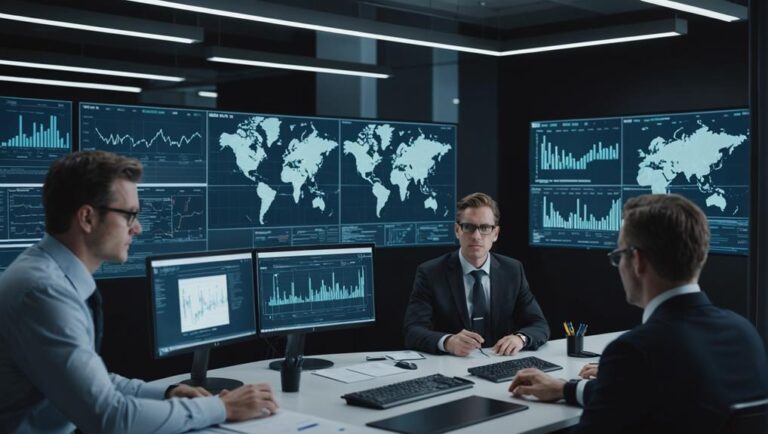Assessing IT Infrastructure in Technology Due Diligence for M&A

When assessing IT infrastructure in technology due diligence for M&A, we prioritize key areas. We start by examining the reliability and compatibility of hardware and software, ensuring they align with operational requirements and future needs.
Then, we analyze the network architecture for scalability and potential security vulnerabilities. It's crucial to review data storage capabilities, considering both capacity and security measures to safeguard sensitive information.
We also evaluate the efficiency of the IT staff in maintenance and their ability to adapt to technological advancements.
Moreover, understanding integration costs and potential compatibility issues is essential for anticipating challenges post-merger. By delving deeper into these aspects, we can uncover critical strategies to facilitate a seamless transition and ensure a robust alignment of infrastructure.
This detailed evaluation helps mitigate risks and ensures a successful integration of IT systems in the M&A process.
Key Takeaways
- Assess the reliability and scalability of servers to meet future operational demands effectively.
- Evaluate the network architecture for seamless scalability, optimal performance, and robust cybersecurity measures to ensure a secure integration process.
- Analyze the current storage capacity and its scalability potential to accommodate the increasing data requirements efficiently.
- Review the readiness and efficiency of the IT staff in managing and troubleshooting systems during the integration phase.
- Identify any hidden integration costs, such as hardware and software compatibility issues, to facilitate a smooth transition post-merger.
Evaluating Hardware and Software
When evaluating hardware and software during mergers and acquisitions, it's crucial to thoroughly assess the reliability and compatibility of servers, storage devices, and production tools with the target company's operations. Ensuring seamless alignment of the technology with their specific needs is vital for fostering innovation and driving growth.
Starting with hardware components, we must determine if the servers are sufficiently robust to handle both current and future demands. Assessing the capacity and speed of storage devices is also essential. Identifying any outdated hardware that could hinder digital transformation initiatives is key. These technical evaluations help in deciding whether to utilize existing assets or opt for significant upgrades.
Moving on to the software landscape, it's imperative to understand the proprietary software, intellectual property, support status, and licensing agreements in place. Evaluating the software development processes is necessary to gauge efficiency and sustainability. This analysis helps in assessing the potential risks and benefits associated with the current software setup.
Additionally, examining the network setup and cybersecurity measures is crucial, although a detailed analysis of these aspects will be conducted later.
Assessing Network and Cybersecurity
Assessing the network and cybersecurity infrastructure ensures that our IT systems are strong, adaptable, and resistant to potential threats. Initially, we scrutinize the network structure to ensure it meets scalability, reliability, and performance standards, in line with current and future business requirements. This involves a thorough examination of network architecture to pinpoint any security vulnerabilities and compliance gaps that may jeopardize our IT framework.
Subsequently, our focus shifts to evaluating the cybersecurity measures in place, emphasizing data security methods and encryption protocols. We conduct comprehensive vulnerability assessments to uncover and address any weaknesses that could be exploited by malicious entities. Additionally, we review access controls to guarantee that only authorized individuals have access to sensitive data, thereby reducing the likelihood of data breaches.
Critical to our assessment are the incident response procedures. It's imperative to verify the existence of robust protocols for detecting, responding to, and recovering from security incidents. This ensures swift containment and mitigation of any breaches.
Reviewing Data Storage Capabilities
When assessing data storage capabilities, the initial step involves evaluating the current storage capacity in terabytes to ensure it meets existing needs and anticipates future growth.
Subsequently, the focus shifts to scalability, ensuring that the systems can adapt as data requirements expand. An examination of the storage solutions, whether cloud-based, on-premises, or hybrid, is conducted to ascertain their suitability and flexibility for the organization.
Security measures play a critical role in this evaluation. Encryption protocols, access controls, and the robustness of backup systems are assessed to safeguard data integrity and availability.
Performance metrics like latency, throughput, and reliability provide insights into the efficiency of storage solutions under different loads, directly impacting operational effectiveness.
Cost considerations are also a key aspect of the review. Ongoing costs, including direct expenses and maintenance-related costs, are analyzed to understand the financial implications.
Effective disaster recovery plans are essential to ensure business continuity in scenarios involving data loss or system failures. The implementation of regular maintenance practices and the ability to recover swiftly from disruptions are vital for sustaining long-term operational success.
Understanding IT Staff and Operations
In assessing data storage capabilities, the next step involves evaluating the maturity and preparedness of the target company's IT staff to effectively handle technical operations. Within our Technical Due Diligence process, the operational sophistication of the IT team holds significant importance. We will examine how well the IT staff oversee processes and uphold systems, ensuring smooth customer communication and support services.
The primary objective is to scrutinize the efficiency of technical operations and ascertain the IT team's effectiveness in maintaining and troubleshooting systems. By gauging their ability to adapt to changes, we can assess their readiness for the ever-evolving technological landscape. This information is crucial for comprehending the potential integration and ongoing innovation within the company.
Outlined below are key areas of focus:
| Key Area | Evaluation Criteria |
|---|---|
| IT Operations Readiness | Capability in managing processes and systems |
| Efficiency of Technical Operations | Proficiency in maintenance and troubleshooting |
| Adaptability to Changes | Response to technological evolution |
These elements collectively provide insight into the IT staff's capabilities and the sophistication of their operational processes. By identifying strengths and weaknesses, we can better grasp how the IT team can steer innovation and enhance efficiency. This comprehensive understanding aids in making well-informed decisions regarding the target company's technical infrastructure and its future prospects.
Identifying Integration Costs and Efforts
Understanding the complexities of integration costs and efforts is pivotal for a successful merger and acquisition (M&A) deal, as it directly impacts the overall value of the transaction and the synergy post-merger.
When assessing the IT infrastructure, a thorough examination of M&A integration costs is essential. This includes identifying potential compatibility issues between existing systems, which can significantly affect the complexities of integration. Whether it involves system migrations, network configurations, or software analysis, each component necessitates meticulous scrutiny.
A comprehensive evaluation of hardware and software is crucial to estimating the actual costs associated with merging two distinct IT environments. A detailed hardware assessment and software analysis can uncover hidden costs that may otherwise go unnoticed. These hidden costs often stem from unforeseen compatibility issues or integration complexities, which can hinder the success of the post-merger integration.
Furthermore, grasping network configurations is imperative to preempt post-merger challenges. Early assessment of these elements aids in planning for system migrations and aligning the IT strategies of both companies. By taking these steps, we can streamline the process, minimize disruptions, and ensure a smoother integration.
Ultimately, identifying all integration costs and efforts not only equips us for the financial impact but also fortifies the overall synergy of the merged entity.
Frequently Asked Questions
How Do You Perform Due Diligence in Technology?
We perform due diligence by assessing security measures, cloud compatibility, software licenses, data integration, vendor oversight, system scalability, application functionality, compliance requirements, cost evaluation, and team skills to ensure alignment with innovation and operational excellence in M&A technology transactions. This comprehensive evaluation encompasses various aspects of technology integration, including analyzing potential risks and opportunities, verifying data security protocols, and ensuring seamless compatibility between different systems. By scrutinizing these critical elements, we aim to mitigate risks, maximize value, and facilitate a smooth transition during the M&A process.
What Is Information Technology Due Diligence?
Exploring IT due diligence involves uncovering crucial aspects such as data security, software licensing, vendor contracts, system scalability, cyber risks, cloud integration, legacy systems, IT governance, technology stack, and compliance requirements. This deep dive into the technology infrastructure of a company is vital in the context of mergers and acquisitions, where understanding the intricacies of the target company's IT landscape can significantly impact the success of the deal.
Effective due diligence in M&A transactions requires a thorough examination of the target company's IT systems to ensure compatibility, identify potential risks, and uncover opportunities for integration and improvement. By scrutinizing factors like data security measures, software agreements, and regulatory compliance, acquirers can mitigate risks and make informed decisions regarding the acquisition. Additionally, evaluating the scalability and efficiency of the IT infrastructure can provide valuable insights into the company's future growth potential and operational resilience.
In today's digital age, where technology plays a critical role in business operations, conducting comprehensive IT due diligence is essential for minimizing uncertainties and maximizing the value of M&A transactions. By assessing the target company's technology stack, evaluating its cybersecurity measures, and understanding its IT governance structure, acquirers can ensure a smooth transition and alignment of IT capabilities post-acquisition. Ultimately, thorough IT due diligence is key to unlocking synergies, mitigating risks, and driving successful outcomes in M&A deals.
What Is Due Diligence in Infrastructure?
We evaluate the scalability, network security, and vendor agreements involved in mergers and acquisitions. Assessing the data centers, cloud integration, and adherence to compliance standards is crucial during this process. Our review includes analyzing hardware inventory, maintenance schedules, backup procedures, and disaster recovery plans to ensure a resilient and cutting-edge IT infrastructure for the merged entities.
During M&A technology due diligence, it is imperative to thoroughly examine the infrastructure scalability to accommodate the increased demands of the combined businesses. Network security assessments are conducted to identify any vulnerabilities that may pose a risk to the integrated operations. Additionally, scrutinizing vendor contracts helps in understanding the obligations and liabilities related to the technology services being utilized.
When evaluating data centers and cloud integration, we focus on the efficiency and compatibility of the systems to streamline the post-merger operations. Compliance standards are meticulously reviewed to ensure that the merged entity meets all regulatory requirements and industry best practices. By examining hardware inventory, maintenance schedules, backup procedures, and disaster recovery protocols, we aim to guarantee a seamless transition and continuity of IT services for the newly merged organization.
How Do You Assess Due Diligence?
We evaluate due diligence in mergers and acquisitions by conducting comprehensive third-party assessments, carefully reviewing vendor contracts, and identifying potential cybersecurity risks. Our process includes performing thorough compliance checks, ensuring data integrity, evaluating system scalability, analyzing network architecture, verifying software licensing, and confirming IT governance adherence. Additionally, we conduct extensive testing of disaster recovery plans to assess their effectiveness in protecting critical business operations.
In M&A technology due diligence, it is crucial to assess the target company's technological infrastructure to determine its compatibility and scalability with the acquiring company's systems. This evaluation involves analyzing the network architecture for potential vulnerabilities and weaknesses, as well as ensuring that the software used is properly licensed to avoid legal issues post-acquisition. By employing a meticulous approach to due diligence, we aim to mitigate risks and maximize the value of the merger or acquisition.
Taking a proactive stance on due diligence is essential in M&A transactions to avoid costly mistakes and ensure a smooth integration process. By following industry best practices and leveraging the latest tools and techniques, we strive to make informed decisions that align with the strategic goals of the acquiring company. Our commitment to thorough due diligence helps us safeguard investments and drive successful outcomes in the dynamic landscape of mergers and acquisitions.
Conclusion
In our M&A technology due diligence process, we thoroughly assessed the hardware and software infrastructure, evaluated network and cybersecurity protocols, reviewed data storage capabilities, analyzed IT staff expertise and operational efficiency, and identified integration costs and complexities.
This comprehensive approach ensures a thorough understanding of all potential risks and opportunities associated with the target company. By conducting due diligence in this meticulous manner, we not only protect our investment but also set the stage for smooth integration and future growth, demonstrating our dedication to strategic and well-informed decision-making.





